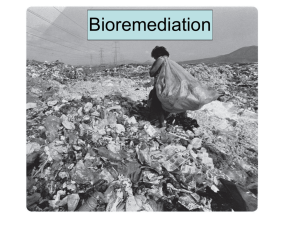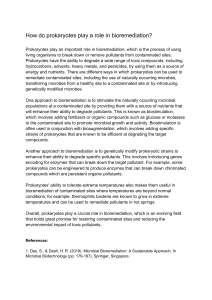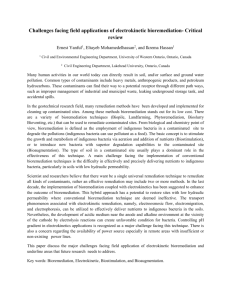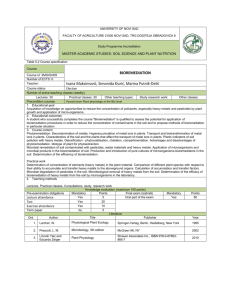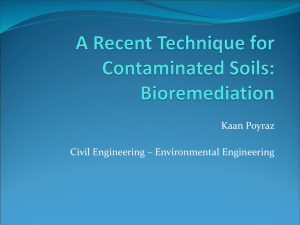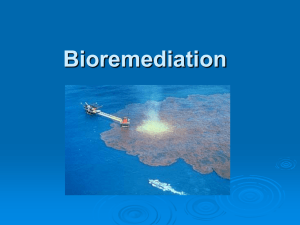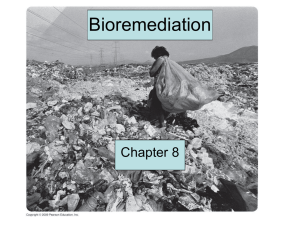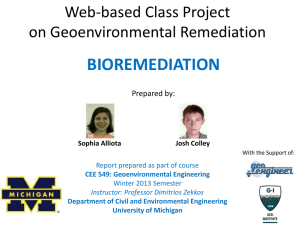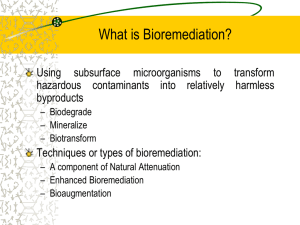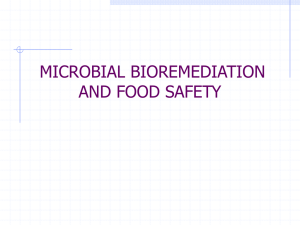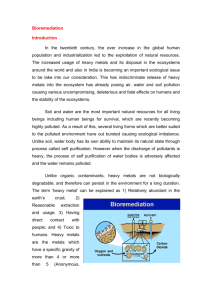Bioremediation
advertisement
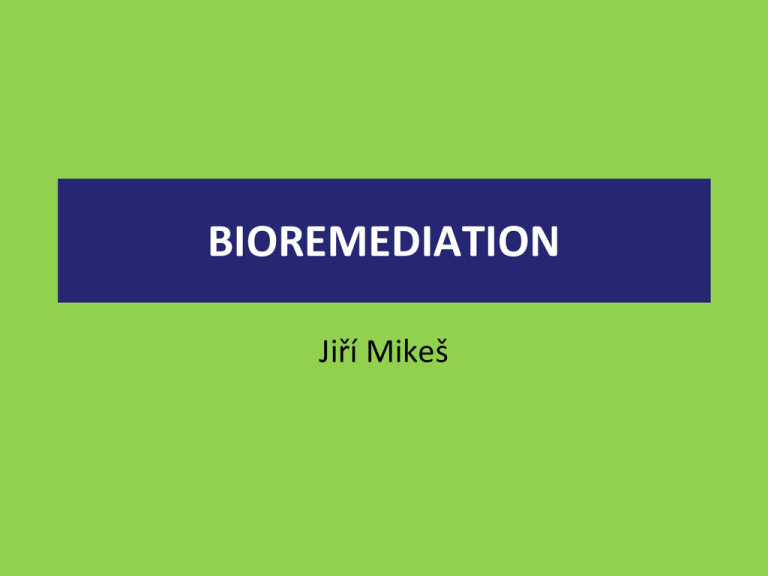
BIOREMEDIATION Jiří Mikeš Bioremediation "use of living organisms (e.g., bacteria) to clean up oil spills or remove other pollutants from soil, water, and wastewater.“ Source: United States Environmental Protection Agency, Office of Compliance and Assurance “clean-up of pollution from soil, groundwater, surface water and air, using biological, usually microbiological processes” Source: Philp et al., 2001 Bioremediation Bioremediation relies largely on the enzymatic activities of living organisms, usually microbes, to catalyze the destruction of pollutants or their transformation to less harmful forms. Bioremediation Why are microorganisms so important in this process? They have extraordinary metabolic diversity! Bioremediation A complex process depending on many factors including: ambient environmental conditions composition of the microbial community nature and amount of pollution present Ambient environmental conditions pH temperature lack of nutrients & molecular oxygen soil particles are not homogeneous in terms of oxygen content contour map of [O2] in a soil particle Composition of the microbial community depends on the environment soil has very complex microbial communities with hundreds of: Types of pollutants Types of pollutants Organic pollutants → catabolized Naturally occurring Xenobiotics - substances foreign to an entire biological system, i.e. artificial substances, which did not exist in nature before their synthesis by humans Metals from ore extraction and manufacturing Contaminants Potentially Amenable to Bioremediation Readily degradable ____________ _ Somewhat Difficult to Generally degradable degrade recalcitrant _____________ _____________ _____________ fuel oils, gasoline creosote, coal tars chlorinated solvents (TCE) dioxins ketones and alcohols pentachlorophenol (PCP) some pesticides and herbicides polychlorinated biphenyls (PCB) monocyclic aromatics bicyclic aromatics (naphthalene) Biological solution Fundamentals of cleanup reactions • Aerobic metabolism – Microbes use O2 in their metabolism to degrade contaminants • Anaerobic metabolism – Microbes substitute another chemical for O2 to degrade contaminants • Nitrate, iron, sulfate, carbon dioxide, uranium, technicium, perchlorate Cometabolism Bacterium uses some other carbon and energy source to partially degrade contaminant (organic aromatic ring compound) contaminant degradation products bacterium corn starch CO2 + H2O What types of treatment technologies are in use to remove contaminants from the environment? • • • • • • • • Soil vapor extraction air sparging bioremediation thermal desorption soil washing chemical dehalogenation soil extraction in situ soil flushing What Makes Bioremediation a Promising Approach? • permanence – contaminant is degraded • potentially low cost – 60-90% less than other technologies Economics of in-situ vs. ex-situ remediation of contaminated soils • Cost of treating contaminated soil in place $80$100 per ton • Cost of excavating and trucking contaminated soil off for incineration is $400 per ton. • Over 90% of the chemical substances classified as hazardous today can be biodegraded. Bioremediation techniques Natural attenuation In situ bioremediation Ex situ bioremediation Phytoremediation NA – MNA & ENA Natural Attenuation Bioventing Airsparging In-situ bioremediation Biostimulation Biostimulation Biostimulation Bioreactors Bioremediation Research Bioaugmentation vs. biostimulation: Biostimulation involves the modification of the environment to stimulate existing microorganisms capable of bioremediation. Indigenous populations may not be capable of degrading the xenobiotics or the wide range of potential substrates present in complex pollutant mixtures. Bioaugmentation is the introduction of a group of natural microbial strains or a genetically engineered variant to treat contaminated soil or water. Careers in Bioremediation • Outdoor inspection • Lab testing • Administration Government Employee Regulatory oversight Company employee Summary • Many factors control biodegradability of a contaminant in the environment • Before attempting to employ bioremediation technology, one needs to conduct a thorough characterization of the environment where the contaminant exists, including the microbiology, geochemistry, mineralogy, geophysics, and hydrology of the system
